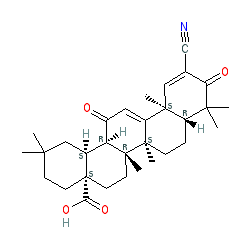|
Synonyms: CDDO | RTA-401
Compound class:
Synthetic organic
Comment: Bardoxolone was a Phase 3 NF-κB signaling inhibitor [2]. Although the recommended INN for this compound is bardoxolone, it is administered as bardoxolone methyl which has ChEMBL ID CHEMBL1762621. Bardoxolone can be described as a KEAP1 antagonist, as it antigonises KEAP1 interaction with the Nrf2 transription factor [1]. As this action releases Nrf2 from the inhibitory effect of the protein-protein interaction, it can also be described as a functional Nrf2 activator.
Ligand Activity Visualisation ChartsThese are box plot that provide a unique visualisation, summarising all the activity data for a ligand taken from ChEMBL and GtoPdb across multiple targets and species. Click on a plot to see the median, interquartile range, low and high data points. A value of zero indicates that no data are available. A separate chart is created for each target, and where possible the algorithm tries to merge ChEMBL and GtoPdb targets by matching them on name and UniProt accession, for each available species. However, please note that inconsistency in naming of targets may lead to data for the same target being reported across multiple charts. ✖ |
|
|||||||||||||||||||||||||||||||||||
| No information available. |
Summary of Clinical Use  |
| Clinical trials for treatment of chronic kidney disease (CKD) as a result of type 2 diabetes mellitus have been terminated. Visit ClinicalTrials.gov to view currently registered drug trials involving this compound. |
Mechanism Of Action and Pharmacodynamic Effects  |
| Bardoxolone inhibits the ubiquitinisation activity of KEAP1, a protein which interacts with and ubiquitinises the Nrf2 transcription factor (NFE2L2, Q16236) and sequesters Nrf2 to the cytoplasm. Bardoxolone-induced activation of Nrf2 leads to activation of Keap1-Nrf2 pathway which regulates genes (containing antioxidant response elements (AREs)) involved in antioxidant and anti-inflammatory responses [2-3,5]. |








